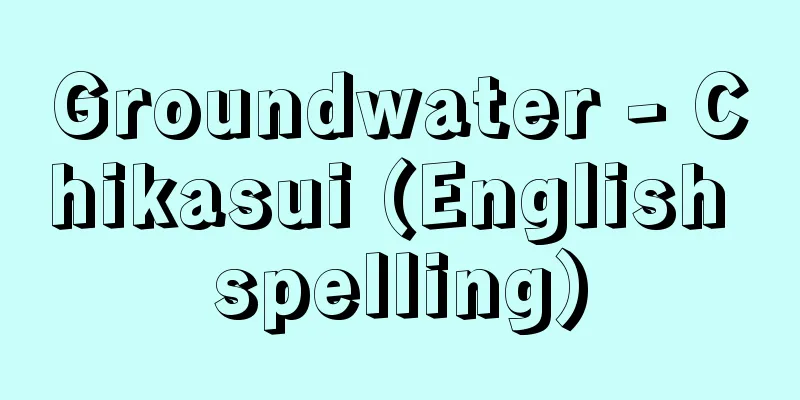Groundwater - Chikasui (English spelling)

|
Groundwater is water that exists underground and fills the gaps in the strata below the groundwater level. In relation to water use and civil engineering works, groundwater is sometimes limited to water that can be collected by wells, tunnels, drainage channels, etc., or water that naturally flows into springs and wetlands. When a well is dug, the surface that connects the water levels that first appear in the well is called the groundwater level. Below this level, the strata are saturated with water, so it is called the saturated zone, and above this level, it is not saturated with water and air is present, so it is called the vadose zone. In reality, the layer just above the groundwater level is almost saturated, with water being held there by capillary force. The depth of the groundwater level varies from just above the ground surface to 1,000 meters or even deeper, depending on the location. In Japan, which is in a humid region, the groundwater level is usually around 5 meters deep, and rarely exceeds 20 meters, but in volcanic foothills, it can be more than 100 meters deep in some places. [Isamu Kayane] Groundwater occurrence and classificationA permeable stratum that can transmit sufficient groundwater to wells and springs is called an aquifer. The most common aquifers are unconsolidated sand and gravel layers, which are found in plains and alluvial valleys. Consolidated sandstone, limestone with developed pores, and volcanic rock with well-developed cracks are also good aquifers. Clay, silt, and dense sedimentary rocks have low permeability, and are classified as impermeable, low-permeable, or semi-permeable depending on their degree of permeability. When these strata are in contact with the top of an aquifer, they are called pressurized layers. Groundwater can be divided into unconfined groundwater (free groundwater) that has a water table, and confined groundwater (deep groundwater) that is below a pressurized layer and pressurized above atmospheric pressure. shows schematics of various types of aquifers. Aquifer A is an unconfined aquifer whose upper limit is the groundwater table, and the water pressure at the groundwater table is equal to atmospheric pressure. The explanation at the top of this figure is for confined aquifer B, which is sandwiched between unconfined aquifer A and confined aquifer C. The water level of a well drilled in a confined aquifer generally rises above the base of the upper pressurized layer, and the water level is determined by the pressure distribution inside the aquifer. The imaginary surface connecting the water levels of these wells is called the pressurized head surface. Unlike the groundwater level, the pressurized head surface does not indicate the upper limit of the confined aquifer, but its upper limit is the boundary surface with the upper pressurized layer. Therefore, fluctuations in the pressurized head surface are an indicator of pressure changes inside the confined aquifer, but have no direct relationship to the increase or decrease in the amount of confined groundwater stored. The pressurized head surface can be located anywhere from within the upper pressurized layer to above the ground surface. If a well is drilled in a place where the pressurized head surface is above the ground surface, the water level of the confined well will be higher than the ground surface, and if the top of the well frame is lower than the pressurized head surface, groundwater will naturally overflow from the well and become an artesian well. An area where artesian wells can be found is called an artesian zone, and a large one is called an artesian basin. Artesian basins are typically found in areas with monoclinic or basin-like structures, and the Great Artesian Basin in Australia is a good example. Artesian zones are found at the tips of alluvial fans, at the foot of volcanoes, on the edges of sand dunes and plateaus, and in valley plains. In the schematic diagram, groundwater in aquifer B is recharged in the recharge zone at the left edge. This part of the aquifer is unconfined because it has a groundwater table. The groundwater flows along the gradient of the pressurized head surface, leaking into aquifers A and C, and finally flowing out into the sea. In nature, it is rare for a completely impermeable layer to be a pressurized layer, so the exchange of groundwater between aquifers is a very common phenomenon. Groundwater with a groundwater table distributed over a wide area is sometimes called main water. If there is a narrow impermeable or semi-permeable layer between the main water and the ground surface, perched water will form on top of it. The Musashino Plateau in the western suburbs of Tokyo is an area where perched water is well developed, and in the early stages of new rice field development, settlements were found built on perched water. [Isamu Kayane] Groundwater flowGroundwater moves from areas of high hydraulic head to areas of low hydraulic head. Hydraulic head is defined as the vertical distance from a reference level (e.g. sea level) to the confined head or water table. Hydraulic head is sometimes called piezo head or total potential. In the schematic diagram, the hydraulic head of aquifer B is higher than that of aquifers A and C at every point, so groundwater leaks from B to A and C where the confined layer is semi-permeable. If development of aquifer B progresses and its hydraulic head becomes lower than that of A and C due to pumping, groundwater may leak from A and C to B. The position of the saltwater-freshwater interface in an unconfined aquifer facing the sea is H = 42h in static equilibrium, where h is the elevation above sea level of the groundwater surface and H is the depth from the sea level to the saltwater-freshwater interface. This equation is called the Geyben-Herzberg relationship after its discoverer. The actual position of the saltwater-freshwater interface is deeper than in the case of static equilibrium, because groundwater flows out near the coast, as shown in the schematic diagram. When pumping water from a well near the coast, if the water level in the well is lowered below sea level, saltwater rises into the well. This phenomenon is called saltwater intrusion, and it occurs frequently in areas where coastal groundwater development has been carried out without planning. Since groundwater loses its value as a water resource when it flows out into the sea, various construction methods have been considered to utilize coastal groundwater without saltwater intrusion. One of these is the artificial barrier. This method involves setting up a row of injection wells along the coastline and artificially injecting groundwater to raise the groundwater table, thereby preventing the groundwater from seeping out to the seabed, and also setting up pumping wells inland from the injection wells to pump up both the injected groundwater and groundwater flowing from inland toward the coast. This method is being implemented on the coasts of California in the United States and Israel. [Isamu Kayane] Interaction with surface waterRiver water is recharged by groundwater when there is no rainfall. On average, it is thought that about one-third of river flow comes from groundwater on a global average. Rivers can be classified into two types based on their relationship with groundwater ( ): rechargeable rivers, which collect groundwater as they flow downstream and increase in volume, and non-rechargeable rivers, which recharge into groundwater and decrease in volume as they flow downstream. Rechargeable rivers are commonly found in humid regions, and drain groundwater, forming valleys along the river course above the groundwater table. Non-rechargeable rivers are commonly found in alluvial fans and arid regions, and groundwater is recharged from the river, forming ridges above the groundwater table along the river course. Even in rechargeable rivers, if pumping is done near the river to lower the groundwater level below the river level, the river water will sink and become groundwater. This method of using groundwater is called induced recharge. In Nagaoka City, Niigata Prefecture, where a large amount of groundwater is used to melt snow, a large amount of induced recharge occurs from the Shinano River in winter. Lake water also has an exchange relationship with groundwater. In humid regions, precipitation is greater than evaporation, so lake water must become groundwater and flow out of the bottom of a closed lake with no outflow river, such as Lake Ikeda in Kagoshima Prefecture, into the surrounding area. There are several abnormally cold springs around Lake Ikeda, which confirm the leakage of cold lake water. Meanwhile, at the bottom of Lake Biwa, a fault lake in Shiga Prefecture, a large amount of groundwater from the lake shore leaks directly into the lake bottom without passing through a river. In addition, in shallow lakes such as Lake Kasumigaura in Ibaraki Prefecture, most of the groundwater flows out to the lowlands on the lake shore, and only a small amount leaks into the lake bottom. [Isamu Kayane] Groundwater flow rateIn 1856, French engineer Henry Darcy (1803-1858) conducted an experiment on the flow of water through a sand-filled cylinder and discovered an important law that forms the basis of groundwater flow, called Darcy's Law, which is expressed by the following equation. q = Q / A = KI [Isamu Kayane] Age of groundwaterThe age of groundwater can be determined by using radioisotopes such as carbon-14, tritium, and radon contained in groundwater. The age of groundwater in the Sahara Desert in Africa and the Carrizo Sandstone in Texas, USA, is 20,000 to 30,000 years, and it was recharged during the glacial period, and its flow rate is extremely slow at 1 to 2 meters per year. In the USA, the average age of groundwater shallower than 800 meters (also called groundwater residence time) is estimated to be about 200 years, and that deeper than 800 meters is about 10,000 years. In Japan, the average age of shallow groundwater in small mountain basins is estimated to be several years, shallow groundwater in diluvial plateaus is several decades, and confined groundwater in the Kanto tectonic basin is several decades to several hundred years, and the existence of groundwater older than 10,000 years has been confirmed. The reason why the average age of groundwater is so old is because the amount of groundwater stored is significantly greater than the amount of recharge. However, groundwater does not circulate uniformly; its circulation speed is faster at the surface and slower at deeper levels. Most of the groundwater recharged from the surface flows through the shallow layers and flows out into nearby rivers, lakes, marshes, and wetlands. [Isamu Kayane] Groundwater qualityThe quality of groundwater is determined by its contact with the strata as it flows underground. Because the flow rate of groundwater is very slow, it has a long contact time with the strata, and chemical components dissolve into the groundwater. Also, because groundwater is isolated from the atmosphere, dissolved oxygen is consumed and reduced by the decomposition of organic matter, and the groundwater is placed in a reducing state. As a result, there is an increase in ferrous ions, an increase in ammonia, and a decrease in sulfate ions. Also, carbon dioxide produced as a result of the decomposition of organic matter dissolves into the groundwater, dissolving cations from the strata components. In general, the deeper the groundwater, the greater the amount of dissolved substances, the more oxygen is consumed, the closer it approaches a reducing state, and the greater the alkalinity. However, the quality of groundwater is fundamentally governed by the properties of the strata. The quality of groundwater in Japan is generally good because of its fast circulation. In 1985, the Environment Agency (now the Ministry of the Environment) selected the "100 Best Waters of the Showa Era" and about 80% of them were groundwater or spring water. This shows the importance of groundwater in the environment. In contrast, groundwater deep in the continent contains a lot of dissolved substances, especially salt, and there is also fossil seawater that was absorbed during sedimentation. Contaminants originating from human activities have been increasingly found in groundwater that has been in residence for more than several decades. Possible causes include dumping of contaminants into wells, conversion of shallow groundwater to deep groundwater through wells, and drawing of contaminated water into deep layers due to excessive pumping. Possible sources of groundwater contamination include point sources such as industrial wastewater, household wastewater, and mine wastewater, and non-point sources such as fertilizers, pesticides, herbicides, and livestock manure. [Isamu Kayane] Groundwater contaminationThe quality of natural groundwater is determined by the type and amount of eluted components from the strata that it comes into contact with as it flows underground, but groundwater pollution can refer to either the infiltration of pollutants into groundwater by human activity, which changes the original water quality, or the inclusion of many substances harmful to humans in the original groundwater components, which impedes its use or poses health hazards to humans and livestock. In the former case, the soil and geology are contaminated first, and it is not uncommon for the groundwater that passes through the gaps between them to become contaminated, so an increasing number of experts are calling it geological groundwater pollution rather than groundwater pollution. Sources of pollution due to human activities include domestic wastewater and those associated with production activities such as industry, mining, and agriculture, and the three main pollutants are as follows: (1) Organic solvents Organic solvents are widely used as cleaning agents to remove oil in metal processing, integrated circuit production, and clothing dry cleaning. Typical examples include trichloroethylene and tetrachloroethylene, both of which are carcinogenic (cancer-causing). (2) Nitrate ion If an infant ingests a large amount of nitrate ion, it changes the form of iron in hemoglobin, causing methemoglobinemia, which makes it impossible for oxygen to be exchanged. The main sources of nitrate ion are domestic wastewater and nitrogen fertilizer, both of which are decomposed and oxidized, or remain unchanged in chemical form, and ultimately accumulate in groundwater as nitrate ion. (3) Pathogens Contamination by pathogens occurs through the mixing of domestic wastewater or septic tank effluent, or through underground seepage of outdoor compost. It can be said that most groundwater in Japan is now contaminated by organic solvents, and many places are severely contaminated. Nitrate ion concentrations have also been observed to be rising year by year in many places, and the situation is particularly serious in many areas of farming regions where fertilizers are used extensively. Groundwater contamination has spread because the government's consistent policy in the past has been to prohibit drinking groundwater and to instruct people to switch to tap water when contamination is found in drinking groundwater, without any effort to find the source of contamination or remove the contamination. However, in March 1997, environmental standards for groundwater pollution were established, setting standard values for 26 indicators. Technologies for removing contamination have been introduced by private companies, mainly from Europe and the United States, and various methods are becoming available. In cases where groundwater originally contains harmful substances, for example water that contains a lot of inorganic elements such as calcium can cause gallstones and internal organ diseases if consumed over a long period of time. Groundwater with high arsenic content is also known around the world. However, there are many countries and regions that use such groundwater because they have no other water sources. In the 1990s, many wells were dug in developing countries to secure water sources, and arsenic in the strata was leaching into the groundwater, causing serious arsenic poisoning among residents who drank the water, which became a problem in Bangladesh and inland China, and the Japanese government and NGOs (non-governmental organizations) began providing support. Many people in Japan believe that groundwater is clean, but this is often not the case both inside and outside the country, so thorough verification of each individual groundwater is necessary. [Takahashi Takao] Groundwater temperatureThe temperature of groundwater is determined by the earth's temperature (temperature underground). Earth's temperature varies daily and annually depending on the air temperature at the earth's surface. The amplitude of this periodic variation in earth's temperature decreases with depth, and the phase lag increases. The depth at which annual changes in earth's temperature are no longer observed is called the isothermal layer, which is around 10 meters in Hokkaido and 10-15 meters in Honshu, Shikoku, and Kyushu. The groundwater temperature in the isothermal layer is 1-3°C higher than the annual average air temperature at that location, and compared at the same latitude, groundwater temperatures in snowy areas are about 1°C lower than those in non-snowy areas. In Japan, the groundwater temperature below the isothermal layer rises by 3-4°C for every 100 meters. [Isamu Kayane] Groundwater balanceUnder natural conditions, groundwater storage does not change significantly. This is because recharge and runoff are in balance ( ). Recharge comes from precipitation and infiltration from surface water such as rivers, streams, and lakes. Runoff comes from discharge into springs, rivers, lakes, marshes, and oceans, and artificially from pumping water through wells and drainage through streams. If recharge is greater than runoff, the groundwater table rises, and if not, it falls. The rise and fall of the groundwater table indicates an increase or decrease in groundwater storage. Investigating the relationship between groundwater storage, recharge, and runoff is called groundwater balance analysis. Advances in computer technology have made it possible to perform groundwater balance analysis in areas with complex geological conditions. Since groundwater water balance is inseparably related to the water balance of surface water and soil water, groundwater water balance analysis must take these conditions into account and avoid mutual contradictions. Groundwater has superior characteristics as a water resource compared to surface water in terms of water quality, stability of water temperature, ease of extraction, and low cost. It is also the second most abundant inland water on Earth after ice. In arid regions, most water resources are groundwater. However, since groundwater has a low circulation rate, water balance must be taken into consideration when considering long-term use as a resource. Artificial recharge is necessary to pump more water than natural recharge and to use groundwater permanently. Artificial recharge is carried out using artificial ponds, waterways, buried pipes, wells, etc. Groundwater has a large storage capacity and can withstand a water balance deficit for a considerable period of time, so in arid regions, policies to use up all groundwater are sometimes adopted, similar to oil, etc. Obstacles associated with groundwater use include saltwater intrusion, well drying or interference due to a drop in the water level, and land subsidence. Land subsidence is primarily caused by consolidation due to the squeezing of water from the pressurized layers above and below caused by excessive pumping from a confined aquifer, but it can also occur, although the amount of subsidence is small, due to elastic consolidation of the aquifer itself or block movement of the strata due to changes in water pressure underground. [Isamu Kayane] Legal issuesThe Civil Code has some provisions on surface water flowing, albeit insufficient, in terms of neighboring relations, but has no provisions at all on groundwater. Case law has interpreted groundwater as being in principle subject to land ownership, but since groundwater does not remain confined to a certain piece of land, and groundwater that has accumulated there often spreads over other pieces of land, this interpretation is questionable. Rather, groundwater should be considered a right to use groundwater that is independent of land ownership, similar to surface water from rivers and other sources. Hot springs are already recognized as real rights under customary law as hot spring rights. When large amounts of groundwater are used, such as for pumping industrial water, there is a risk of land subsidence. Therefore, the extraction of groundwater is regulated by the Industrial Water Law and the Law Concerning the Regulation of Extraction of Groundwater for Buildings. [Toshio Takeuchi] "Introduction to Groundwater" (1983), edited and published by the Soil Engineering Society of Japan. ▽ "New Edition of Groundwater Survey Methods" (1983, Kokon Shoin), written by Yamamoto Sotake. ▽ "Groundwater Management of Alluvial Fans" (1990, Kokon Shoin), written by Hida Noboru. ▽ "Polluted Groundwater" (1990, Kyoritsu Shuppan), written by Fujinawa Katsuyuki. ▽ "Groundwater Pollution: Its Fundamentals and Applications" (1991, Kyoritsu Shuppan), edited by the Groundwater Problems Study Group. ▽ "Hydrology Lectures 6: Groundwater Hydrology" (1992, Kyoritsu Shuppan), written by Yamamoto Sotake. ▽ "The World of Groundwater" (1992, NHK Publishing), written by Kayane Isamu. ▽ "An Easy Guide to Groundwater" (1993, Hokuto Shuppan), written by the Groundwater Protection Society. ▽ "Groundwater" (1995), edited and published by the Tokyo Metropolitan Research Institute for Environmental Protection . "A method for investigating groundwater flow by measuring temperature" by Takeuchi Atsuo (1996, Kokon Shoin)" ▽ "A revised version of the Groundwater Handbook by Fukuoka Masami, Ochiai Toshiro, and Kayane Isamu (1998, Construction Industry Research Institute)" ▽ "The Science of Famous Water" by the Japanese Association of Groundwater Hydrology (1999, Gihodo Publishing)" ▽ "The Basics of Groundwater Quality: From Famous Water to Groundwater Pollution" by the Japanese Association of Groundwater Hydrology (2000, Riko Tosho)" ▽ "Rainwater Infiltration and Groundwater Recharge: Groundwater Management in the 21st Century" by the Japanese Association of Groundwater Hydrology (2001, Riko Tosho)" ▽ "Measuring Temperature to Diagnose Groundwater: Exploring the Natural State of Groundwater" by Takeuchi Atsuo, Nakayama Kenji, and Watanabe Chieko (2001, Kokon Shoin)" [Reference items] | | | | | | | | | | | | | | | | | | | | | | | | | | | | | | | | | | | | | |©Shogakukan "> Groundwater occurrence and classification (schematic diagram) [Figure A] ©Shogakukan "> Exchange between river water and groundwater (Figure B) ©Shogakukan "> Aquifer Hydraulic Conductivity (Table) ©Shogakukan "> Water balance relationships (Figure C) Source: Shogakukan Encyclopedia Nipponica About Encyclopedia Nipponica Information | Legend |
|
地中にある水のうちで、地下水面より下にあって地層中の間隙(かんげき)を満たして存在している水を地下水という。水利用や土木工事との関係で、井戸、トンネル、排水路などで集めることのできる水、または泉や湿地へ自然状態で流出している水に限って地下水とよぶこともある。井戸を掘ったときに、井戸の中に最初に現れる水面を空間的につなげた面を地下水面という。これより下は地層が水で飽和されているので飽和帯、上は水で飽和されず空気も存在するので通気帯とよばれる。実際には地下水面よりすぐ上の層は毛管力で水が保持されており、ほぼ飽和に近い状態にある。地下水面の深さは、場所によって地表すれすれから1000メートルまたはそれ以深まで変化する。湿潤地域にある日本では、地下水面の深さは5メートル前後が普通で、20メートルを超える場合は少ないが、火山山麓(さんろく)台地では100メートル以深の所もある。 [榧根 勇] 地下水の産状と分類井戸や泉へ十分な量の地下水を伝達できる、透水性のよい地層を帯水層という。もっとも一般的な帯水層は未固結の砂層や礫(れき)層で、平野部や沖積谷に分布する。固結した砂岩、溶穴の発達した石灰岩、割れ目のよく発達した火山岩なども良質の帯水層である。粘土層、シルト層、緻密(ちみつ)な堆積(たいせき)岩などは透水性が低く、透水性の程度に応じて、不透水層、難透水層、半透水層などに分けられる。これらの地層が帯水層の上部に接しているとき、それらを加圧層とよぶ。 地下水は、地下水面を有する不圧地下水(自由地下水)と、加圧層の下にあって大気圧以上に加圧されている被圧地下水(深層地下水)に分けられる。はいろいろなタイプの帯水層を模式的に示したものである。帯水層Aは不圧帯水層で、その上限は地下水面であり、地下水面の水圧は大気圧に等しい。この図の上部に示してある説明は、不圧帯水層Aと被圧帯水層Cに挟まれた被圧帯水層Bに関するものである。 被圧帯水層中にうがたれた井戸の水位は、一般に上部加圧層の基底より上まで上昇し、その水位はその帯水層内部の圧力分布によって決まる。これらの井戸の水位をつなげた仮想的な面を被圧水頭面とよぶ。地下水面とは異なり、被圧水頭面は被圧帯水層の上限を示す面ではなく、上部加圧層との境界面がその上限である。したがって被圧水頭面の変動は、被圧帯水層内部の圧力変化の指標とはなるが、被圧地下水の貯留量の増減とは直接的な関係はない。被圧水頭面は上部加圧層中から地表面より上までいろいろな位置をとりうる。被圧水頭面が地表面よりも上にある場所に井戸をうがつと、被圧井の水位は地表面よりも高くなり、もしもその井戸の井戸枠の上端が被圧水頭面よりも低ければ、地下水は井戸から自然にあふれ出して自噴井となる。自噴井の見られる地域を自噴帯、その大規模なものを鑽井盆地(さんせいぼんち)という。鑽井盆地は単斜構造や盆状構造の地域で典型的にみられ、オーストラリアの大鑽井盆地(グレート・アーテジアン・ベイスンThe Great Artesian Basin)はその好例である。自噴帯は扇状地の扇端部、火山山麓、砂丘や台地の縁辺部、谷底平野などに分布する。 模式図の帯水層Bの地下水は、左端の涵養(かんよう)域で涵養される。この部分の帯水層は地下水面を有するので不圧帯水層である。地下水は被圧水頭面の勾配(こうばい)に沿って流れ、帯水層AやCへ地下水を漏出させながら、最終的には海へ流出する。自然界では、完全な不透水層が加圧層となっている場合はまれであるから、帯水層間の地下水の交流はごく普通の現象である。広い地域に分布する地下水面をもつ地下水を本水(ほんみず)とよぶことがある。本水と地表面との間に狭い範囲で不透水層または半透水層が存在すると、その上に宙水(ちゅうみず)が形成される。東京西郊の武蔵野(むさしの)台地は宙水がよく発達している地域で、新田開発の初期には宙水に立地した集落がみられた。 [榧根 勇] 地下水の流動地下水は水理水頭の高い所から低い所へ移動する。水理水頭は基準面(たとえば海面)から被圧水頭面または地下水面までの垂直距離と定義される。水理水頭はピエゾ水頭または全ポテンシャルとよばれることもある。模式図では、帯水層Bの水理水頭はどの場所においても帯水層AやCよりも高いので、加圧層が半透水性の所ではBからAやCへ地下水が漏出する。帯水層Bの開発が進んで、揚水によりその水理水頭がAやCの水理水頭よりも低くなれば、逆にAやCからBへ向かう地下水の漏出もおこりうる。 海に面する不圧帯水層中の塩淡水境界面の位置は、地下水面の海抜標高をh、海面から塩淡水境界面までの深さをHとすると、静的平衡状態ではH=42hとなり、この式を発見者の名にちなんでガイベン‐ヘルツベルクの関係という。実際の塩淡水境界面の位置は、模式図のように地下水が海岸付近で流出するため、静的平衡の場合よりも深くなる。海岸の近くで井戸から揚水する場合に、井戸の水位を海面下まで下げると、井戸の中へ塩水が上昇してくる。このような現象を塩水侵入といい、海岸地下水の開発が無計画に進められた地域で頻発している。地下水は海へ流出してしまうと水資源としての価値を失うので、塩水侵入をおこすことなく海岸地下水を利用するために、さまざまな工法が考えられている。その一つに人工バリアがある。これは、海岸線に沿って列状に注入井を設け、地下水を人工注入して地下水面の高まりをつくり、それによって海底へしみ出す地下水の流出を防ぐとともに、注入井の内陸側に揚水井を設けて、注入した地下水と内陸側から海岸へ向かって流出してくる地下水をともに揚水する方法であり、アメリカ合衆国のカリフォルニアやイスラエルの海岸で実施されている。 [榧根 勇] 地表水との交流無降雨時の河川水は地下水によって涵養されている。世界の平均では、河川流量の約3分の1は地下水によると考えられている。河川は地下水との交流関係()によって、流下するにつれて地下水を集めて水量を増す得水河川と、地下水への涵養で流下するにつれて水量を減じる失水河川に分類できる。得水河川は湿潤地域で一般的にみられ、地下水を排水しているので、地下水面上には川筋に沿う谷部が形成される。失水河川は扇状地や乾燥地域に多くみられ、地下水は河川からの涵養を受けるため、川筋に沿って地下水面上に尾根部が形成される。得水河川でも、川の近くで揚水を行い地下水位を河川水位以下まで低下させると、河川水が伏没して地下水に転化する。このような地下水の利用法を誘発涵養という。 消雪用水に地下水を大量に利用している新潟県長岡市では、冬期に信濃(しなの)川から大量の誘発涵養が生じている。湖水も地下水と交流関係をもっている。湿潤地域では蒸発量よりも降水量が多いので、鹿児島県の池田湖のような流出河川をもたない閉じた湖の湖底からは、湖水が地下水となって周辺地域へ流出していなければならない。池田湖の周辺には、異常に低温な湧水(ゆうすい)地がいくつかあり、低温な湖水の漏出を裏づけている。一方、断層湖である滋賀県の琵琶湖(びわこ)の湖底には、湖岸の地下水が河川を経由せずに直接湖底へ大量に漏出している。また、茨城県の霞ヶ浦(かすみがうら)のような浅い湖では、地下水の大部分は湖岸低地へ流出し、湖底へ漏出する量は少ない。 [榧根 勇] 地下水の流速1856年にフランスの工学者ダルシーHenry Darcy(1803―1858)は、砂を詰めた円柱の中の水の流れについて実験を行い、地下水流動の基礎となる重要な法則を発見した。これはダルシーの法則とよばれ次式で表現される。 q=Q/A=KI [榧根 勇] 地下水の年齢地下水に含まれる炭素14、トリチウム(三重水素)、ラドンなどの放射性同位体を利用すると地下水の年齢を決定できる。アフリカのサハラ砂漠やアメリカ合衆国テキサス州カリゾ砂岩の地下水の年齢は2万~3万年で、氷期に涵養された水であり、その流速は年当り1~2メートルときわめて遅い。アメリカ合衆国では、800メートル以浅の地下水の平均年齢(地下水の滞留時間ともいう)は約200年、800メートル以深のそれは約1万年と推定されている。日本では、山地小流域の浅層地下水の平均年齢は数年、洪積台地の浅層地下水は十数年、関東構造盆地の揚水中の被圧地下水は数十年ないし数百年と推定されており、1万年以上の地下水の存在も確認されている。 地下水の平均年齢がこのように古いのは、涵養量に比べて地下水の貯留量が著しく多いからである。しかし地下水は一様に混合して循環しているのではなく、その循環速度は表層ほど速く、深層ほど遅い。地表から涵養された地下水の大部分は、浅層部を流動して近くの河川、湖沼や湿地へ流出する。 [榧根 勇] 地下水の水質地下水の水質は、地下水が地中を流動していく過程で、地層との接触によって形成される。地下水の流速は非常に小さいので、地層との接触時間が長く、化学成分が地下水中に溶出する。また地下水は大気と遮断されているので、溶存酸素は有機物の分解によって消費され減少していき、地下水は還元状態に置かれる。その結果、第一鉄イオンの増加、アンモニアの増加、硫酸イオンの減少などがみられる。また、有機物分解の結果生じた二酸化炭素は地下水中に溶けていき、地層成分から陽イオンを溶出する。一般に深層の地下水ほど溶存物質の量が多く、酸素が消費されて還元状態に近づき、アルカリ度は大きくなる。しかし、地下水の水質は基本的には地層の性質に支配される。 日本の地下水の水質は、循環速度が速いため一般に良質である。1985年(昭和60)に環境庁(現、環境省)が選定した「昭和の名水百選」のうち約8割は地下水または湧水であった。このことから、環境中に占める地下水の重要性がうかがわれる。これに対して大陸深層部の地下水は多量の溶存物質、とくに塩分を含むものが多く、地層堆積時に取り込まれた化石海水もある。滞留時間が数十年を超えるような地下水中に、人間活動に由来する汚染物質が発見されることが増えてきたが、その原因としては、井戸への汚染物質の投棄、井戸を通しての浅層地下水の深層地下水への転化、過度な揚水に伴う汚染水の深層への引き込みなどが考えられる。地下水の汚染源としては、点源として工場排水、家庭排水、鉱山排水など、面源として肥料、殺虫剤、除草剤、畜産糞尿(ふんにょう)などが考えられる。 [榧根 勇] 地下水汚染天然地下水の水質は、地中を流動していく際に接触する地層からの溶出成分の種類と量で規定されるが、地下水汚染とは、人間活動によって汚濁物質が地下水に入り込み、本来の水質が改変されることをさす場合と、もともとの地下水成分に人間に有害な物質が多く含まれ、その利用が妨げられたり、人間や家畜に健康被害を与えることをさす場合とがある。前者の場合は、まず、土壌、地質が汚染され、その間隙を通過する地下水が汚染されることも少なくないので、地下水汚染とよばず、地質地下水汚染とよぶ専門家も増えている。 人間活動による汚染源としては、生活排水や工業、鉱業、農業など生産活動に伴うものがあり、おもな汚染物質としては以下の三つがある。 (1)有機溶剤 有機溶剤は、金属加工や集積回路生産で、あるいは衣類のドライクリーニングで、油落としの洗浄剤として多用されるもので、代表的なものにトリクロロエチレン、テトラクロロエチレンなどがあり、いずれも発癌(がん)性を有している。 (2)硝酸イオン 硝酸イオンは、乳児が多く摂取すると、ヘモグロビン中の鉄の形態が変わり、酸素の授受ができなくなるメトヘモグロビン血症を引き起こす。硝酸イオンの主たる起源は生活排水と窒素肥料で、どちらも分解、酸化されて、あるいは終始化学形を変えることなく、最終的に硝酸イオンとして地下水中に蓄積される。 (3)病原菌 病原菌による汚染は、生活排水、浄化槽排水の混入や野積堆肥の地下浸透などによって起こる。 現在、日本のほとんどの地下水が有機溶剤で汚染されているといえ、汚染がはなはだしい所も多い。硝酸イオン濃度も年々上昇していることが各地で観測されており、とくに肥料を多用する畑作地帯で深刻な状況にある所が少なくない。地下水汚染が拡大したのは、飲用地下水に汚染が発見されると、飲用を禁じて水道水への切り替えを指導することがこれまでの行政の一貫した方針で、汚染源を探したり汚染を除いたりすることが、なされてこなかったからである。しかし、1997年(平成9)3月に地下水の水質汚濁にかかわる環境基準が制定され、26指標に関して基準値が定められた。汚染を除去する技術は、民間企業によって主として欧米からの技術導入が進み、さまざまな手法が用意されつつある。 地下水にもともと有害物質が含まれる場合では、たとえばカルシウムなどの無機成分が多く含まれた水を長期間飲用すると、胆石や内臓疾患を引き起こす。またヒ素含量が多い地下水も世界各地で知られている。しかしほかに水源が得られないため、そのような地下水を使用している国や地域は少なくない。 1990年代に入ると、開発途上国で水源確保のため多くの井戸が掘られ、その際、地層中のヒ素が地下水に溶け出し、飲用した住民に深刻なヒ素中毒が生じていることがバングラデシュや中国内陸部で問題になり、日本の政府やNGO(非政府組織)が支援を始めている。日本では地下水は清浄であると思っている人が多いが、国の内外を問わずそうとはいえないことが多いので、個々の地下水について十分な検証が必要である。 [高橋敬雄] 地下水の水温地下水の水温は地温(地中温度)によって決定される。地温は、地表で気温の影響を受けて日変化、年変化する。このような地温の周期的変動の振幅は、深さが増すとともに減少し、位相の遅れは大きくなる。地温の年変化がみられなくなる深さを恒温層といい、その深さは北海道で10メートル前後、本州、四国、九州で10~15メートルである。恒温層の地下水温は、その場所の年平均気温よりも1~3℃高く、同じ緯度で比較すると、積雪地域の地下水温は非積雪地域のそれよりも1℃ほど低い。恒温層以深の地下水温は日本では100メートルにつき3~4℃ずつ上昇する。 [榧根 勇] 地下水の水収支自然状態では地下水貯留量に著しい変化は生じない。それは涵養と流出がつり合っているからである()。涵養は降水、河川、水路、湖沼など地表水からの浸透による。流出は湧泉、河川、湖沼、湿地、海洋への流出、人工的には井戸による揚水や水路による排水による。涵養量が流出量よりも多ければ地下水面は上昇し、逆であれば低下する。地下水面の昇降は地下水貯留量の増減を示している。このように、地下水の貯留量、涵養量、流出量の関係を調べることを地下水の水収支解析という。コンピュータ技術の発達によって、複雑な地質条件の地域についても地下水の水収支解析が可能になった。地下水の水収支は地表水や土壌水の水収支と不可分の関係にあるので、地下水の水収支解析はこれらの条件を考慮し、相互に矛盾の生じないように行わなければならない。 地下水は、水質、水温の安定性、採水の容易さ、コストの安さなどの点で、水資源としては地表水よりも優れた特性をもっている。また地球上にある陸水のなかでは氷に次いで多い。乾燥地域では水資源の大部分が地下水である。しかし地下水は循環速度が小さいから、資源として長期にわたる利用を考える場合には水収支を考慮する必要がある。自然涵養を上回る揚水を行い、しかも永続的に地下水を利用するためには人工涵養が必要である。人工涵養は人工の池、水路、埋管、井戸などで行われる。地下水は貯留量が多く、かなりの年月にわたって水収支的赤字に耐えられるので、石油などと同様に、乾燥地域では地下水を使いきる政策がとられることもある。地下水利用に伴う障害には塩水侵入のほか、水位低下による井戸枯れや井戸干渉と、地盤沈下がある。地盤沈下は、被圧帯水層からの過剰な揚水に起因する上下の加圧層からの水の絞り出しによる圧密が主原因であるが、沈下量は小さいが帯水層自体の弾性圧密や、地中の水圧変化による地層のブロック運動が原因になって生じる場合もある。 [榧根 勇] 法律問題民法は、地表の流水については、相隣関係として不十分ながら規定を設けているが、地下水についてはまったく規定を設けていない。判例は、地下水につき、原則的に土地所有権が及ぶものと解しているが、地下流水は一定の土地にとどまっているわけではないし、地下滞留水も他の土地にまたがっている場合が少なくないので、このような解釈には疑問が残る。むしろ、河川等の地表水に準じて、土地所有権から独立した地下水利用権と考えるべきであろう。温泉については、すでに温泉権として慣習法上の物権と認められている。工業用水のくみ揚げのように、地下水が多量に利用される場合には、地盤沈下などを生ずるおそれがある。そこで、「工業用水法」や「建築物用地下水の採取の規制に関する法律」により、地下水採取の規制がなされている。 [竹内俊雄] 『土質工学会編・刊『地下水入門』(1983)』▽『山本荘毅著『新版地下水調査法』(1983・古今書院)』▽『肥田登著『扇状地の地下水管理』(1990・古今書院)』▽『藤縄克之著『汚染される地下水』(1990・共立出版)』▽『地下水問題研究会編『地下水汚染 その基礎と応用』(1991・共立出版)』▽『山本荘毅著『水文学講座6 地下水水文学』(1992・共立出版)』▽『榧根勇著『地下水の世界』(1992・日本放送出版会)』▽『地下水を守る会著『やさしい地下水の話』(1993・北斗出版)』▽『東京都環境科学研究所編・刊『地下水』(1995)』▽『竹内篤雄著『温度測定による流動地下水調査法』(1996・古今書院)』▽『福岡正巳・落合敏郎・榧根勇著『地下水ハンドブック』改訂(1998・建設産業調査会)』▽『日本地下水学会著『名水を科学する』(1999・技報堂出版)』▽『日本地下水学会著『地下水水質の基礎 名水から地下水汚染まで』(2000・理工図書)』▽『日本地下水学会著『雨水浸透・地下水涵養――21世紀の地下水管理』(2001・理工図書)』▽『竹内篤雄・中山健二・渡辺知恵子著『温度を測って地下水を診断する あるがままの地下水の姿を探る』(2001・古今書院)』 [参照項目] | | | | | | | | | | | | | | | | | | | | | | | | | | | | | | | | | | | | | |©Shogakukan"> 地下水の産状と分類(模式図)〔図A〕 ©Shogakukan"> 河川水と地下水との交流〔図B〕 ©Shogakukan"> 帯水層の透水係数〔表〕 ©Shogakukan"> 水収支の相互関係〔図C〕 出典 小学館 日本大百科全書(ニッポニカ)日本大百科全書(ニッポニカ)について 情報 | 凡例 |
>>: Underground resources - Chikashigen (English spelling)
Recommend
Giant eel (English name: Anguilla marmorata)
A fish of the order Anguilliformes and family Angu...
Deep shoes - Fukuto
Also written as 'Fuka-suki'. A type of foo...
Iimoriyama
[1] [noun] A mountain shaped like a pile of rice. ...
Feelings of the Cliffs
…He was the nephew of Oriental historian Naka Mic...
Large vehicle license - Large vehicle license
...Therefore, maintaining and observing traffic o...
KANU - Kanu
Kenya African National Union (Kenya African Nation...
Asian golden cat (English spelling) Felis temmincki; Asian golden cat
Carnivora, Felidae. Body length 75-105cm. Body col...
Retired Emperor - Daijoko
〘Noun〙 (also "Taishokou") = Daijo Tenno ...
James Muspratt
1793‐1886 British chemical industrialist. Born in ...
The beautiful Mount Asama
Kabuki. Historical piece. Three acts. Said to be t...
Ring-tailed lemur
It is a member of the mammalian class, primate or...
Kanto Court Approval
...The main points of both sides' arguments a...
America Village - America Village
The nickname for the area around Mitsu Park, near ...
snobbery
…It is often translated as “snobbish” or “gentlem...
Fission weapon
...If the delivery vehicle (missile, etc.) and th...



![Minami Kiso [town] - Nagiso](/upload/images/67cc655b78b4e.webp)





